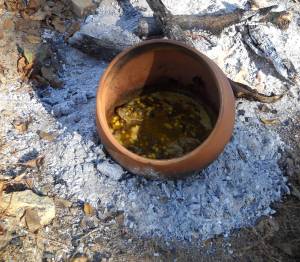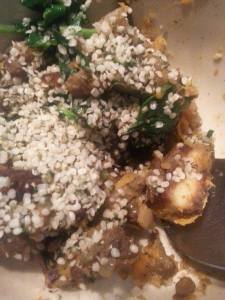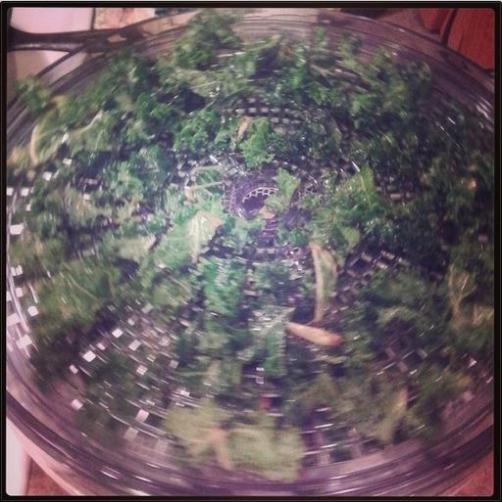
Three Sisters Soup
We have an upcoming event this weekend where I work as a mestiza cook! “Giving Thanks” is one of our biggest events and we always appear on our local news station. Today, we showcased an Apalachee-style recipe called “Three Sisters Soup.” My co-cook, Helena, always does really well in the televised cooking segments and I am happy that she agrees to do them. We try to show something different every year. In the past, Pollo Moruna was one we showed.
The “Three Sisters” refers to the three vegetables in this soup: corn (maize), beans, and squash. The Apalachee grew these three crops well before the Europeans ever visited what is now Florida. The Apalachee were well-known for their prolific farms, which was one of the reasons the Spanish came to the territory. The reason they are called the “Three Sisters” is because of their method of cultivation. These three crops are grown together. The corn is planted first and each stalk is planted on its own mound that is about 18 inches wide, about 4-6 inches high. When the stalk is about knee-high, the bean is planted right at the base. The type of bean grown locally was a Phaseolus vulgaris. The kidney bean is a well-known member of this species and is a vine rather than bush bean. As the vine grows, it uses the corn stalk as a pole for support. The bean returns the favor of support by supplying the corn with nitrogen that it adds to the soil. Corn grows best in nitrogen rich soil. Let’s not forget about the third sister, squash! Squash is also a vine and has nice broad leaves. As the squash grows along the ground in and among the corn and bean mounds, it acts as a natural weed suppressant. It shades the soil, filtering the sun and making weeds grow slower. It also helps to slow water from evaporating from the soil. That’s a very helpful action considering the Apalachee were watering immense fields by hand. The National Center for Appropriate Technology’s (NCAT) Sustainable Agriculture Project has a great publication you can download for free that goes further into this method of companion planting. To view the section that discusses just the Three Sisters, go here. It’s funny how we sometimes think that our methods of conservation are “new” and “innovative.” Sometimes we just need to look at the past and learn from what has already been done and make further improvements on those methods rather than trying to reinvent the wheel. But I digress.
This recipe is as simple or as complicated as you want to make it. Native American recipes of yore weren’t as seasoning-heavy as today’s recipes sometimes are. Most of the spices that we use today were introduced by the Europeans, e.g. cinnamon, black pepper, and nutmeg, so none of them are represented in this recipe.
The term “sage” is, actually, quite general. It can refer to several different plants that aren’t very similar. Plants that contain the term “sage” cover several different families and not all are edible. Salvia officinalis is an herb that is in the mint family. This is the “rubbed sage” you might have in your kitchen cabinet at home. This is the species represented in the recipe below as it is the most readily available species in grocery stores, but it is not native to the New World. It comes from Southern Europe and the Near East. Salvia apiana, however is what is native to the New World and it is found in North America’s Southwest region. This is the sage that is sacred to the Native Americans and is the one that is burned in ceremonial settings. To simplify things, and I love simplification where it’s appropriate, we will be using Salvia officinalis in this recipe. What local herb(s) the Apalachee may have chosen in this recipe, I don’t know. We probably won’t know either due to the fact the Apalachee didn’t have a written form or record of their language until after the Europeans came and what we do know has largely been lost or wasn’t deemed “significant enough” by the Spanish to merit recording.
Now that we know a little of the history of this recipe, let’s talk about the recipe itself. This recipe is very forgiving. You really don’t need to worry much about exact measurements and substitutions can easily be made. There are more tips after the recipe.
Prep time: 15 minutes
Cook time: about 1 hour
Ingredients:
•2 quarts water
•1 cooked turkey thigh OR 2 cooked turkey wings (smoked turkey tastes best) OR 1 ½ cups cooked turkey meat
•2 cups prepared corn
•2 cups prepared and rinsed kidney beans
•1 cup cubed pumpkin/squash
•1 medium onion, chopped
•Several fresh chopped sage leaves or 2 teaspoons dried/rubbed sage
•2 teaspoons salt (or more to taste)
Directions
1. Put the 2 quarts of water and turkey into a large pot and bring it to a boil. Boil for about 15 minutes.
2. To the same pot, add the corn, beans, and pumpkin/squash. Lower heat to medium-high and allow them to continue to gently boil for another 15 minutes. Add a little more water if necessary.
3. Add the onion, sage, and salt. Lower to medium heat and allow to cook for a further 30 minutes.
4. If you used meat still on the bone, remove turkey from the soup and place on a plate. Remove the meat from the bones and tear or cut into small pieces. Be careful, it’s hot! Discard the bones and return the meat to the soup.
5.Serve and enjoy!
Pro Tips:
It’s a good way to use your Thanksgiving leftovers.
You can use sweet potato rather than pumpkin or squash.
Our recipe is very basic. It is very versatile and can easily be changed to fit your tastes.
This is a perfect recipe for the crock pot. Just put everything in at once and let it cook for a few hours on “low.”
Any kind of bean works well: lima, pinto…or even a mix!
Add a few Tablespoons of mashed potatoes as a thickener.
0.000000
0.000000
 I sauteed finely chopped vidalia onion in processed (don’t judge me!) coconut oil in a cast iron skillet. I removed the onion and added more oil. Measuring by hunger, I added to the oil salt, fresh ground black pepper, ground cumin, and garlic powder. I added cubed paneer and browned the cubes on two sides. I added back the onion as well as poblano, butternut squash, brown lentils, and a handful of fresh spinach leaves. I turned off the heat, but I left the skillet on the hot burner as I folded everything together and wilted the spinach. When everything was combined well, I plated it and garnished it with raw hemp seed.
I sauteed finely chopped vidalia onion in processed (don’t judge me!) coconut oil in a cast iron skillet. I removed the onion and added more oil. Measuring by hunger, I added to the oil salt, fresh ground black pepper, ground cumin, and garlic powder. I added cubed paneer and browned the cubes on two sides. I added back the onion as well as poblano, butternut squash, brown lentils, and a handful of fresh spinach leaves. I turned off the heat, but I left the skillet on the hot burner as I folded everything together and wilted the spinach. When everything was combined well, I plated it and garnished it with raw hemp seed.

